There were US$51.4 billion in commercial aircraft deals on Day Two of the Farnborough International Airshow led by Embraer racking up hundreds of orders for its E1 and E2 regional jets, as John Walton reports from Farnborough.

The Farnborough International Airshow is steaming of ahead of previous records. Over the two days so far, US$95.5 billion of aircraft have been ordered, with engine and service agreements reaching a combined total of US$98 billion — some $23 billion more than the first two days of the previous show in 2016.
The news of the morning echoed the global headlines as Boeing sold nearly US$12 billion of widebody 747-8F and 777F freighters to Russia’s Volga-Dnepr Group and CargoLogicHolding, respectively.
Big news came from an as-yet-unnamed airline, codenamed Moxy, run by serial commercial aviation startup entrepreneur David Neeleman, who ordered 60 Airbus A220-300 (formerly Bombardier C Series CS300) aircraft just minutes before popping next door to Embraer to pick up a cool 21 next-generation E195-E2 regional jets for Brazilian carrier Azul.
Airbus, meanwhile, ascribed a hundred A320neo aircraft and eight A350-900 aircraft to undisclosed customers.
Undisclosed Customer is really stealing the show here. #FIA18
— Niall O'Keeffe (@niallokeeffe) July 17, 2018
Embraer secured a colossal series of orders for its E-Jets in a highly choreographed set of rapid-fire announcements, which are detailed below, including, again, to an “Undisclosed Customer”.
Mitsubishi, meanwhile, provided an update on its MRJ programme — largely internal reorganisations and reaching of project milestones on the delayed 70-90-seat cleansheet jet, which the airframer is now highlighting as a choice apart from the growing Airbus-Bombardier-ATR and Boeing-Embraer duopolies.
Mitsubishi also revealed details of its market forecast for its segment, which predicted about 5,000 aircraft in the 70-100-seater segment would be required over the next 20 years, including more than 700 in the Asia-Pacific region alone. The largest number, more than 2,000, would be needed in North America, including to replace substantial fleets of smaller regional jets.
There were, however, red faces on the apron at Farnborough as the MRJ demonstration aircraft was damaged by the airport ground handlers.
“After the very successful completion of the Mitsubishi Regional Jet’s first flight demonstration at Farnborough International Air Show, during push back to static parking, the aircraft was damaged by a local ground handling company’s tow vehicle. The ground company was unaffiliated with Mitsubishi Aircraft Corporation,” the company said. “After initial evaluation of our aircraft, we have made the decision not to participate in the flight demonstration today.”
https://player.vimeo.com/video/280342513
VIDEO: While the MRJ flew on Day 1 at Farnborough, as this video from the MRJ website showed, there was to be no repeat performance on Day 2.
Embraer vies with Airbus and Boeing with massive order reveal
Revealing six separate orders and commitments for about 300 frames of its current-generation E1 and next-generation E2 regional jets in a big-bang ceremony, Embraer did more for its present-generation E175 than it did for the E2 backlog.
US regional Republic takes 100+100 E1s, two-thirds of the total order
It will surprise few observers familiar with the complexities of the US regional carrier market that Republic Airways, the world’s largest E-Jet operator, signed a letter of intent for 100 firm E175s — which it has the right to convert into E175-E2s, although those larger, heavier aircraft are subject to restrictions under the US airlines’ scope clauses — and a further 100 options for E175s.
Republic operates approximately 190 Embraer E170/175 aircraft under the regional carrier brands of all three major US carriers: American Eagle, Delta Connection and United Express.
Swiss Helvetic picks up 12+12 E2s
Zurich-based Helvetic Airways, currently an operator of seven E190 and five Fokker 100 jets, ordered 12 E190-E2s and purchase rights for 12 more, all with conversion rights to the larger E195-E2. Four of its existing E190s are “in the long term service” of Swiss International Air Lines under an ACMI partnership.
“The first 12 E190-E2 aircraft will begin replacing Helvetic’s five Fokker 100s and seven E190s, starting in late 2019 and completing in autumn 2021,” Embraer said, with the companies noting that “The purchase options for a further 12 aircraft (E190-E2 or E195-E2) will enable Helvetic Airways to grow according to market opportunities.”
Helvetic chief executive Tobias Pogorevc elaborated: “Our existing Embraer fleet is performing with excellent dispatch rates and our Fokker 100s have been very productive in the last 12 years. However, with the new E2 family, Helvetic will consolidate its highly reliable operation with the quietest and most efficient next generation aircraft available. Furthermore, moving from the current E190 to the E2 fleet will be simple for our well-trained pilots, as only two and half days of ‘non-simulator’ transition training is needed.”
Brazil’s Azul takes 21 E2s on firm order
Taking its E2 order book to 51, E195-E2 launch operator Azul signed today for 21 E195-E2 jets on a firm order basis, adding to the 30 E195-E2s signed for in 2015. It will receive its first aircraft in 2019.
“Our fleet of Embraer aircraft has always been and always will be fundamental to our fleet and network strategy,” said Azul chief executive John Rodgerson. “We are very pleased with our current fleet transformation process, the main vector of margin expansion in the next few years. Given that 50 per cent of our E1s will be returned within the next five years, this new order ensures the replacement of these aircraft by fuel-efficient new generation aircraft, contributing to the continuous reduction of our unit costs.”
Kuwait’s Wataniya goes for 10+10 E2s
Another carrier splitting the firm order and purchase right subtotals down the middle is Kuwaiti carrier Wataniya Airways, which signed deals for a potential total of 20 E195-E2s.
“The E195-E2 will allow us to open non-served markets and increase frequencies, delivering better connectivity to the Kuwait market”, Wataniya chief executive Rakan Al-Tuwaijri explained.
John Slattery, president and chief executive of Embraer Commercial Aviation, also noted that “Wataniya will not only be the first E2 operator in the Middle East, but also the worldwide launch customer of our staggered seat business class, which will establish a new level of comfort in business class for crossover narrow-body jets.”
Embraer’s staggered seating is pitched at over 50 inches, and is a substantial upgrade on the previous 1-2 configuration in the pointy end of the regional jets.
““We have chosen the staggered seats to differentiate ourselves from the competition, offering a superior product with extra leg room and better privacy for our customers,” said Wataniya’s Al-Tuwaijri.
Lessor NAC picks up three E190 E1s
Nordic Aviation Capital, which specialises in regional aircraft leased to a wide variety of carriers across the globe, and which owns an existing 134 E-Jets, signed a letter of intent for a further three current-generation E190 E1 aircraft.
And a final two E1s for Mauritania Airways
Africa will be a key battleground in the next generation regional jet and small airliner market, and Embraer’s keenness to win incumbent operator status with small operators using current-generation jets may be behind an announcement of a firm order from Mauritania Airways for two E175 E1s, to be based in the west African airline’s Nouakchott base.
The airline’s existing fleet comprises three 737s of various vintages and one Embraer ERJ-145 small regional jet. It has ambitions to introduce new routes to Europe and the Middle East. It will take delivery of the 76-seater two-class E175s in 2019.
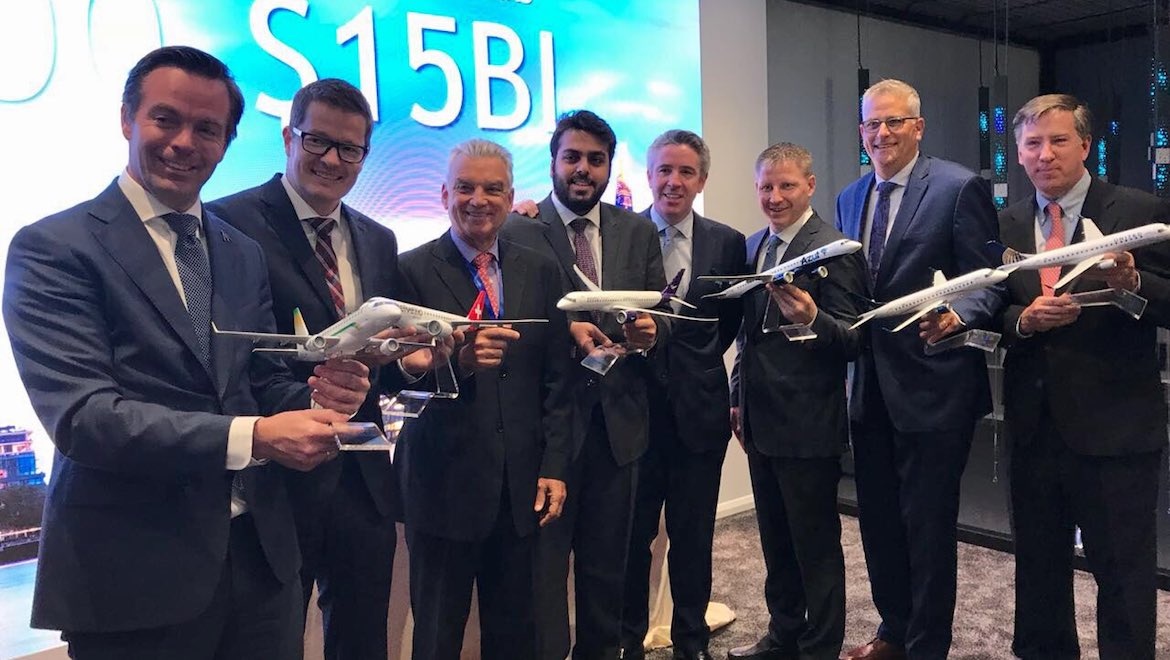
Turning to Airbus, Neeleman shows his A220 moxy, but not for Moxy
When the Marriott group heard aviation entrepreneur David Neeleman was codenaming his next airline “Moxy”, it wasn’t impressed since it has a hotel brand by that name. Airbus, today, sold that carrier the widely expected 60 A220-300 aircraft it was rumoured to be taking, announcing it as “a new US airline start-up” that is “backed up by a group of experienced investors led by David Neeleman, founder of JetBlue, investor in TAP in Portugal and controlling shareholder in Azul airlines in Brazil”.
“After years of US airline consolidation, the conditions are improving for a new generation of US airline to emerge, focused on passenger service and satisfaction,” Neeleman said. “The A220 will enable us to serve thinner routes in comfort without compromising cost, especially on longer-range missions. With deliveries starting in 2021, we will have ample time to assemble a world-class management team and another winning business model.”
Japan low-cost carrier Peach picks Australia-range A321LRs
Japanese low-cost carrier Peach signalled its intention to grow to medium-haul with the conversion of two Airbus A320neo aircraft to the longer range A321LR, based on the stretched A321neo variant. The LR version of the A321neo exchanges Doors 2 for two overwing exits, enabling the LCC to either pack in extra passengers or evolve further to create a more space-efficient premium traveller zone. The 4,000nm range of the A321LR would make routes from its Osaka Kansai hub into a swathe of Australia from northern WA to Queensland a possibility.
Said Airbus chief commercial officer Eric Schulz: “Peach Aviation’s decision proves what we have been thinking at Airbus for a long time: the A321LR further opens the door for us into the mid-range market, offering the best efficiency, lower cost and easiest solution for LCCs to enter the long-haul market.”
“As Japan’s first LCC, Peach has grown earnings and generated profits for five consecutive years,” chief executive Shinichi Inoue said. “However, Peach continues to transform itself and evolve. By taking on the challenge of establishing a medium-haul LCC business in Japan, we will continue to play a leading role in shaping the history of LCCs in Japan and Northeast Asia. The introduction of the A321LR in fiscal 2020 will be the next major step in the evolution of our business and will further accelerate Peach’s transformation into the leading LCC in Asia.”
The airline also said that it would “expand its role as a bridge between Japan and Asia and greatly stimulate inbound demand to Japan,” in the context of “the Japanese government’s goal of 40 million foreign visitors in 2020 and 60 million in 2030”.
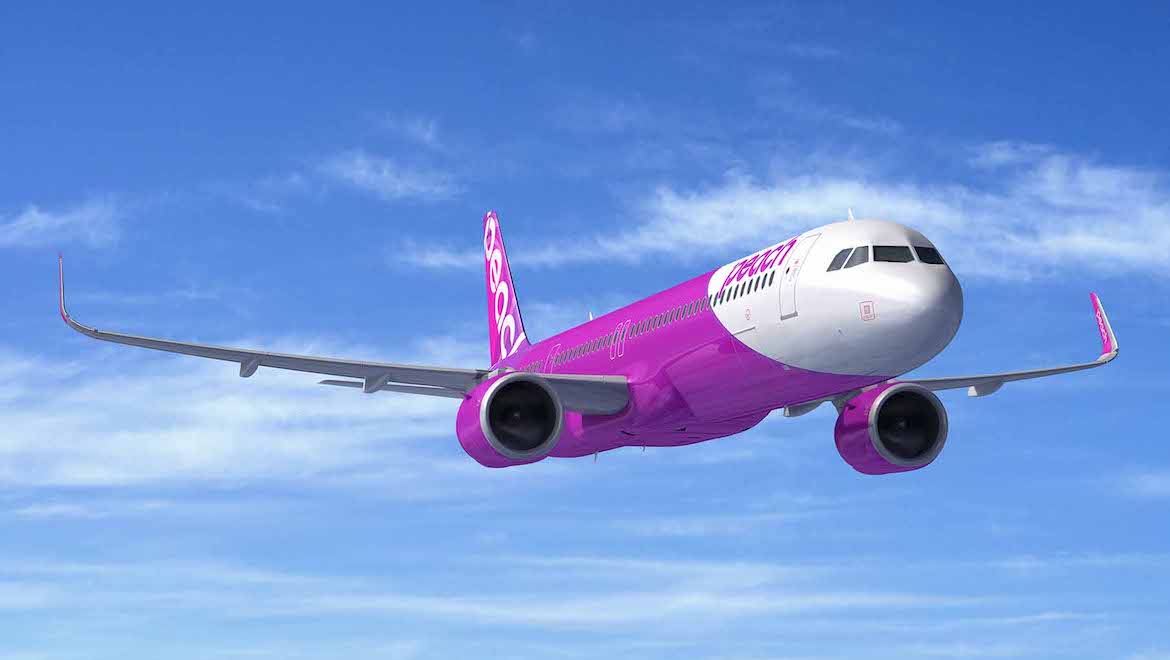
“Secret Squirrel” orders pick up 100 A320neos and 8 A350s
In unveiling two orders from undisclosed customers, Airbus suggested that the A320neo “once again demonstrated its market leadership” with a memorandum of understanding signed by an anonymous airline for 25 A321neo and 75 A320neo aircraft. A further undisclosed customer order for A350-900s was also revealed.
With no A330neo orders, IAG snaps up end-of-line A330-200s for LEVEL
Airbus won’t be delighted that there were no orders for its re-engined A330neo aircraft today at Farnborough, but in the meantime as the current engine option A330ceo line begins to run dry, it seems to be cutting quick deals with airlines to take a few late-model current-generation options. One such deal is the pair of A330-200 aircraft for LEVEL, the low-cost carrier from British Airways-Iberia-Vueling-Aer Lingus parent IAG.
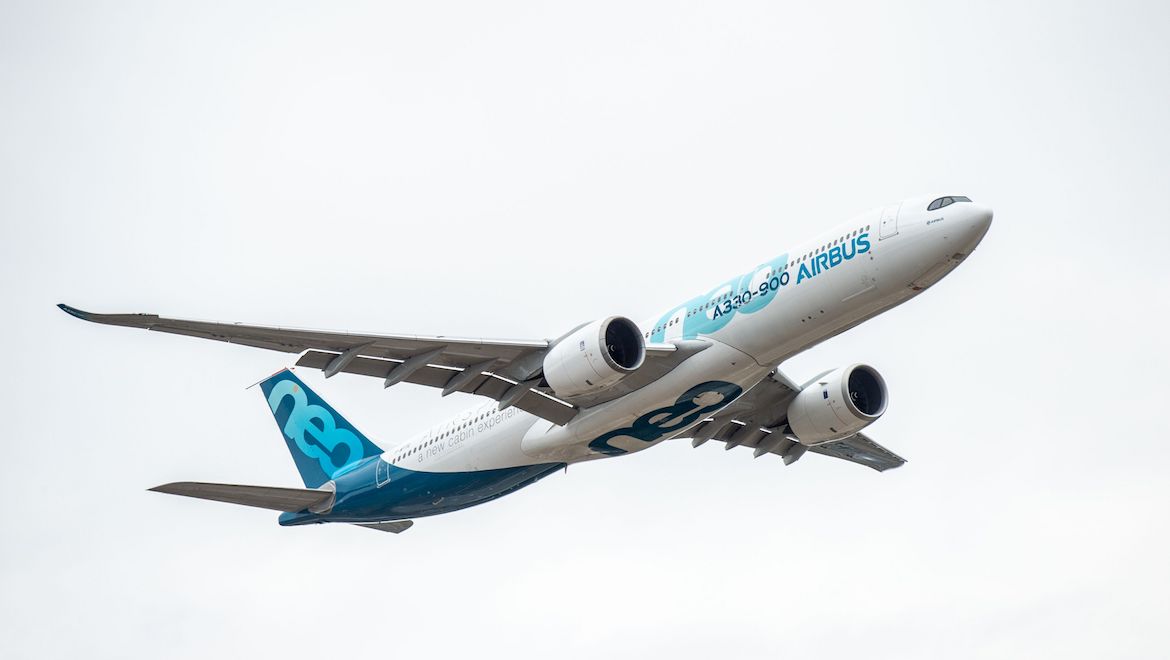
Airbus hands over UK H125 for helicopter training
Airbus delivered the first H125 helicopter to the UK Ministry of Defence’s Empire Test Pilot School, which is a partnership between the MoD and its former research arm, the now-private QinetiQ, training test pilots and flight test engineers.
“The ETPS’ H125s highlight Airbus’ ability in the United Kingdom to deliver mission capabilities for military, law enforcement and security-sector customers. In meeting the ETPS’ training missions, the H125s are being customised by Airbus Helicopters’ UK design team – including the outfitting of a 3-axis autopilot integrated with the ‘glass cockpit’s’ digital flight instrument displays; as well as installing dedicated communications equipment and traffic awareness systems,” the manufacturer said.
IoT benefits will also be realised: the helicopters’ flight test instrumentation suite will transmit realtime data to the ETPS ground school at the MoD’s Boscombe Down facility, enabling the organisation to evaluate both the aircraft’s and its student pilots’ performance.
The deal also comes with a services package: “not only are we delivering a quality product, we’re also ensuring that the H125s will be operated ‘care free’ by QinetiQ – day in and day out – backed the coverage of Airbus Helicopters’ HCare support services package,” Managing Director of Airbus Helicopters UK Colin James said.
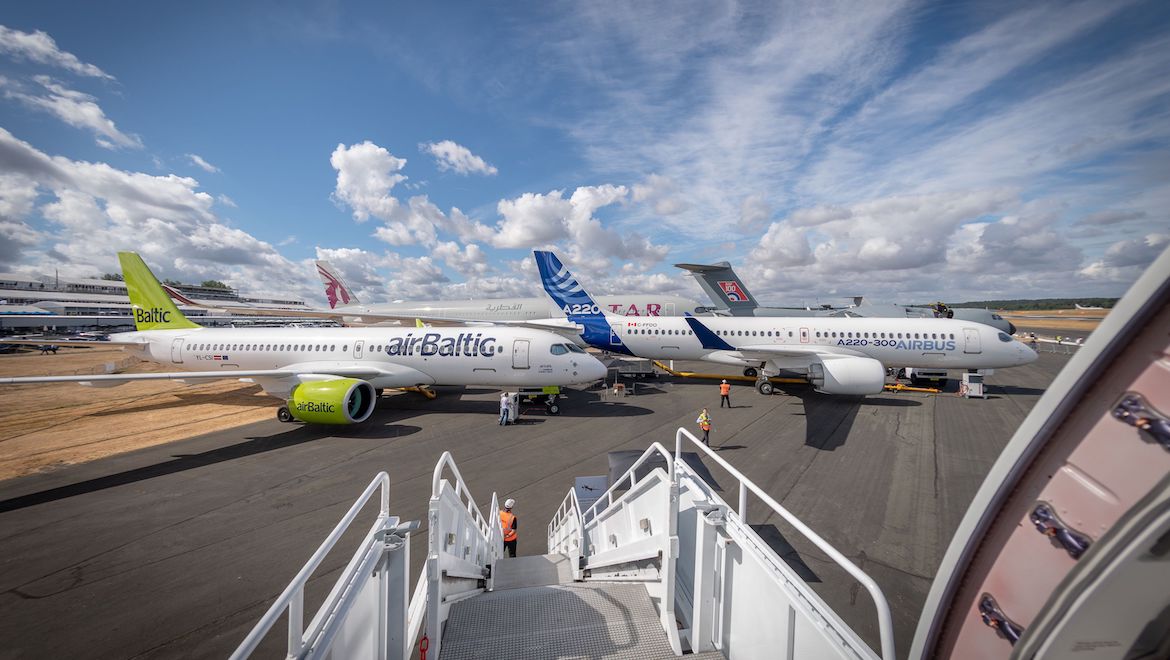
And over at Boeing, it is all about Russia and freighters
As US-Russia intrigue exploded across the world, Boeing seemed to nonchalantly slip out a massive US$9.8 billion order for freighters to the Russian Volga-Dnepr Group and CargoLogicHolding cargo outfits. CargoLogicAir bills itself as “The Great British Cargo Airline”, while Volga-Dnepr is best known for its fleet of massive Antonov An-124 Ruslan freighters.
For its part, Volga-Dnepr confirmed a previous order for five 747-8F cargo aircraft, and planned “to build an unmatched global network for transporting unique, oversize and heavy cargo” according to executives.
“This is a very significant day in our company’s history. With this package of agreements, we will grow our business with the unique and unmatched 747-8 Freighter and open new market opportunities with the 777 Freighter, the world’s longest range twin-engine cargo jet,” Alexey Isaykin, president of Volga-Dnepr Group and chairman of CargoLogicHolding, said. “And we will work with Boeing to develop new freighter solutions that will help us continue to serve the unique and fast-changing requirements of our global customers. We are true believers in the 747-8 Freighter, it is a very special airplane. We fly it every day and we understand why operators around the world want more of them.”
CargoLogicHolding, for its part, will take 29 Boeing 777F freighters, based on the current-generation 777-200LR aircraft. Boeing’s pricing on late-model pre-777X jets is reportedly very keen indeed as the airframer seeks to bridge the gap between spinning down -300ER/200LR production and spinning up the 777-8/9.
“CargoLogicAir, part of CargoLogicHolding, started its business by flying 747 scheduled and charter flights to and from the UK. We are excited to extend the network using a range of Boeing family aircraft including Boeing 747-8F, 777F, 767F and 737-800BCF,” added Alexey Isaykin.
Volga-Dnepr and CargoLogicHolding also signed a “commitment for both companies to explore other freighter solutions, such as new production 767 Freighters or converted cargo jets such as the 737-800 Boeing Converted Freighter.
Boeing’s Global Services arm will also provide AirBridgeCargo, one of the Volga-Dnepr group of airlines, with a crew pairing planning and operations platform. “The program creates optimized work duties, improving crew efficiency and improving airline productivity,” according to the airline. The group is already a Global Services customer in other areas.
“This service puts the most advanced data analytics capabilities at Volga-Dnepr’s hands as they operate the most advanced freighters in the world. It’s a prime example of how Boeing integrates services solutions with the platform to help customers work better, work faster and save on operating costs,” explained Boeing’s Ihssane Mounir, senior vice president of Commercial Sales and Marketing.
Lessor GECAS boosts 737-800 Boeing Converted Freighter orders
General Electric’s commercial aircraft leasing and financing arm GECAS ordered 35 additional Boeing 737-800 converted freighters, the 737-800BCF, in a mix of 20 firm orders and 10 options. GECAS had previously ordered 15 of the converted freighters.
“This order and future commitment with Boeing reflects the confidence GECAS has in the 737-800BCF to replace and grow the narrow body freighter market,” Richard Greener, senior vice president and manager GECAS Cargo Aircraft Group, said. “With total firm and option aircraft commitments now at fifty 737-800BCFs, GECAS will commit nearly $1.5 billion worth of 737-800s with conversions to the narrow body freighter sector.”
GECAS is the launch customer for the 737-800BCF and recently placed its first converted jet with a Swedish cargo airline.
“Existing 737-800 passenger airplanes are modified at multiple facilities, including Boeing Shanghai Aviation Services Co. Ltd., and Taikoo (Shandong) Aircraft Engineering Co. Ltd., also known as STAECO, in China,” Boeing explained in a statement. “Modifications include installing a large main-deck cargo door, a cargo-handling system and accommodations for up to four non-flying crew members or passengers. The 737-800BCF carries more payload – up to 23.9 tonnes (52,800 lbs) and flies farther – 2,000nm (3,750 km) than 737 Classic freighters. The converted jet also offers operators newer technology, better fuel efficiency and reliability than previous standard-body freighters.”
The BCF is part of Boeing’s services strategy, said senior vice president of commercial sales and marketing Ihssane Mounir. “The 737-800BCF is a great example of how Boeing’s Global Services’ business can extend the life of an airplane with new technology and help operators reduce their operating costs.”
Vistara launches longhaul with “up to” 10 787-9s
Indian airline Vistara, which presently operates domestically and is half owned by Singapore Airlines, is to expand its network to longhaul with the purchase of six Boeing 787-9 Dreamliners, plus another four as options. The order makes Vistara India’s first 787-9 Dreamliner operator, although Air India has a fleet of 787-8 aircraft. The Dreamliner, for its part, is Vistara’s first widebody aircraft.
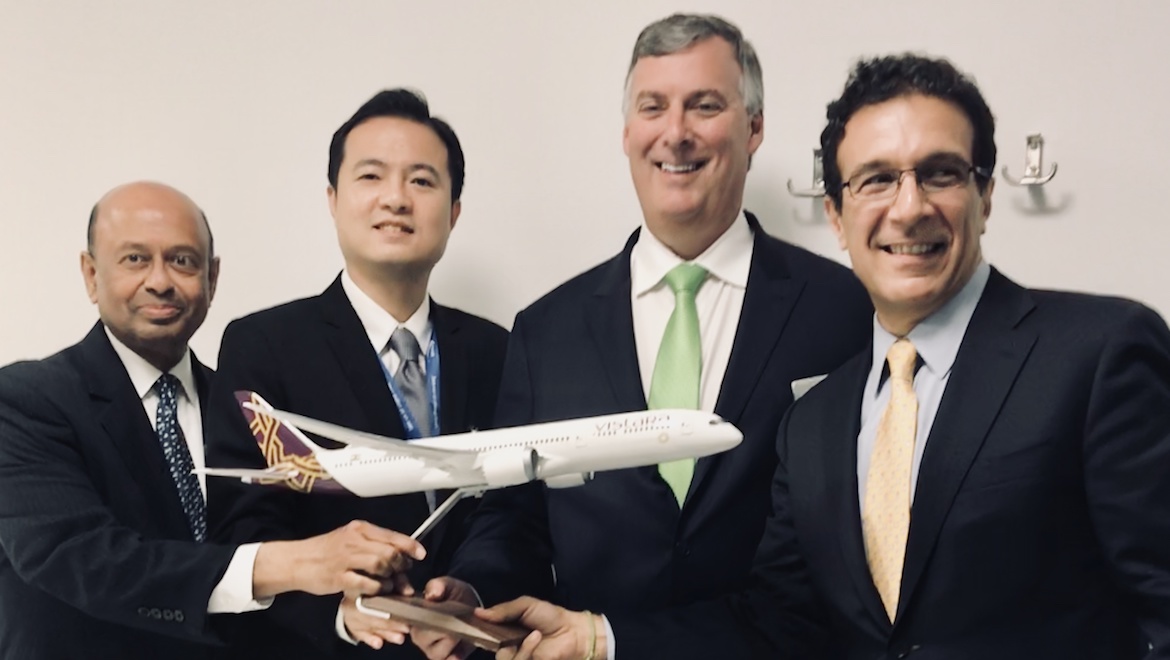
Air Lease boosts a big MAX order, tops up on 787-9
Showing more healthy leasing market capacity, Air Lease Corporation made a firm commitment for 20 Boeing 737 MAX aircraft and three 787-9 Dreamliners, with a further 55 MAX airframes kept as commitments rather than firm orders.
“Demand for reliable, fuel-efficient airplanes is at an all-time high. The capabilities of these new airplanes continue to meet the high expectations of our growing airline customer base,” Steven Udvar-Házy, Air Lease Corporation executive chairman, noted.
The deal tops off ALC’s Boeing 737 MAX orders at 213 jets, of a total Boeing order book of 361 aircraft.
Air Lease also announced at Farnborough that it had placed four 737 MAX 8 jets with Belavia-Belarusian Airlines, which will be delivered to the airline in 2019 and 2020. Lessors are a key part of the capital-light modernisation plans of a number of airlines within the Commonwealth of Independent States.
Lessor Aviation Capital picks up 20 737 MAX
Aviation Capital Group, previously a launch partner of the 737 MAX 10, added 20 further re-engined narrowbodies to its MAX portfolio today, on top of its existing 80-aircraft deals.
“The 737 MAX is core to our strategic growth plans, as the airplane continues to command strong interest in the marketplace,” said Khanh T. Tran, Aviation Capital Group’s chief executive. “This order expands our diverse portfolio, which includes three 737 MAX variants, providing us with more flexibility and some of the most advanced single-aisle jets to serve our customers.”
And one more BBJ MAX makes 20
Rounding out the Boeing news, the company sold a single Boeing Business Jet MAX 7 (based on the similarly named commercial airliner) to Singaporean shipping group Seacons Trading Limited.
“We are excited to announce the BBJ MAX 7 order,” said Dudy Purwagandhi, Seacons Trading Limted chief executive officer. “We already operate a BBJ NG as well as a G550 and we’ve chosen the BBJ MAX 7 because it offers more room and more range. The BBJ MAX 7 has features and capability that allow us to meet our very long distance and demanding international flights with the best passenger comfort in its class.”
The Biman Bangladesh Airlines 787-8 #Dreamliner took to the skies at #FIA18 and put on a spectacular show—wow! #BoeingFIA #avgeek More at: https://t.co/5jFpwSqsCK pic.twitter.com/RQndiZLnOk
— The Boeing Company (@Boeing) July 17, 2018
















Ben
says:Meanwhile the Australian operators are looking at options to purchase yet more geriatric F100 and B717 airframes from these operators that have now signed for new metal.
James
says:@ Ben
Meanwhile the lease rates and purchase prices of these new machines is far more expensive than operating older machines with plenty of cycles left on them. It’s not all about the newest and the flashiest.